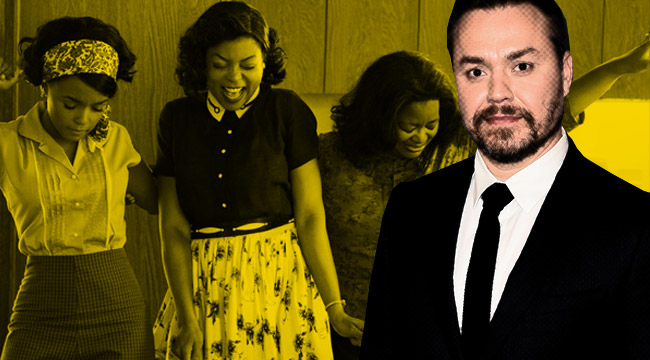
Yes, director Theodore Melfi did notice when awards prognosticators argued that his film, Hidden Figures, was “too populist” to be an Oscar contender. And he’s grateful that his film about three African American women – Katherine Johnson (Taraji P. Henson), Dorothy Vaughan (Octavia Spencer), and Mary Jackson (Janelle Monáe), who overcome institutionalized racism of the early 1960s to help John Glenn orbit around Earth – is considered “too mainstream,” but that’s sure wasn’t what he expected. And now not only is Hidden Figures an Oscar nominee for Best Picture, it’s also the highest grossing Oscar nominee of the season – Hidden Figures even knocked Rogue One out of the top spot at the box office. So, yes, it is both populist and an Oscar contender.
Melfi has seemingly stayed in the background of the Hidden Figures awards push while the film and the actors have done most of the “talking.” (I did ask if this was by design and Melfi admitted it less by “design” and more because he only recently hired a publicist.)
Hidden Figures is only Melfi’s second directorial effort, after 2014’s Bill Murray-starring St. Vincent – but now, his profile has certainly been raised. (Melfi jokes he had a two-day window after Hidden Figure’s big SAG win in which he could get his calls answered.) Ahead, Melfi discusses his “populist Oscar nominee” of a film, and hints that his next film might reunite him with Bill Murray. (And, shockingly, Melfi and Murray have been talking about the film over text message as opposed to Murray’s infamous secret phone number. So, yes, Bill Murray texts now.)
I first saw Hidden Figures right after the election, it made me very emotional.
Yeah, we’ve heard that a lot that the people who saw it right after the election literally had spontaneous bursts of release and cry. But I think what it did, and what it’s done, is a lot of people see that our country was even worse at one point with segregation and how we treated black people and black women and women in general – and then they still got it done right. They still did it right. They still got together and achieved something great. And so, I think it gave everyone a sense that we can get through four years.
There are a few big moments in this movie. When you were working on the script, could you tell then what was going to play big?
I don’t think so. I didn’t. The only time I thought it could be a big moment was when Kevin Costner was tearing down the sign. And I thought it could be a big moment because all that you had seen Katherine go through and to finally get that big satisfaction.
Obviously there needs to be cinematic license in films. That didn’t actually happen, so where does a scene like that come from?
Well, what happened in reality was a man named Floyd Thompson, who was the director of NASA at the time, he sent the memo to all of NASA saying, “I am officially closing the West Computing groups,” and that desegregated NASA. And then he said, “I am transferring all of these women to different positions.” And I have a copy of that memo. So that’s how NASA became desegregated, through that means, and we just wanted to make it more dramatic for the character. Plus, we didn’t have the rights to Floyd’s life.
Did you ask for the rights or was that just not part of the deal from the beginning?
It wasn’t part of the deal from the beginning. All we had the rights to was Margot Lee Shetterly’s book and the three women. So Kevin Costner’s character became this composite and he ended up representing all the men at NASA that were in a position of power. And so, granted, it wasn’t done by Kevin Costner with a crowbar, it was probably done with a maintenance man with a crowbar. But it’s obviously much better to have Kevin Costner than the maintenance man do it. And so that’s how it becomes dramatized. The events are true: The people running to the bathrooms, the sign getting torn down – we just created a more dramatic sense of it.
At first, Hidden Figures wasn’t considered an Oscar contender for some reason.
Well, I saw a few things like that. You know what I think? I think the awards pundits and the reviewers have a similar mindset at some point: and that mindset is, early on, that the more artistic-y, “out there” kind of storylines and movies are the ones that grab Oscar attention. And it’s funny that they would consider three black women mathematicians “mainstream.” I was like, okay, thank you, but I wouldn’t necessarily label it. So I think the initial gut reaction is, “Oh no, it feels too much like it’s for everyone.”
That was the argument: “Too many people are going to like it.”
Yeah. Well, you know, Alan Arkin said something to me. He said to me, “This movie, it may just be too good for awards.”
That’s a nice compliment.
And I understood what he was saying. The artsy-fartsy crowd seems to win the day at the Oscars, or be the ones they talk about. But I don’t think it’s the case this year. I mean, La La Land is a very populist movie. And so is Hidden Figures and so is Arrival. Those are very populist movies.
Though critics in general were very much on this movie’s side.
It’s gotten as many good reviews as any film of the year. I think it’s like 93 percent on Rotten Tomatoes. The only thing I secretly wanted was that the cast be recognized. Because I thought together they were just so stunning and that’s what I really had hoped for. I could care less about anything else but the cast. They worked so hard and they gave every ounce of their souls to this movie and they all did it for next to nothing. I was hoping – really, really hoping – for Taraji. I think her work is unbelievable, extraordinary, and so different than what she’s been doing. I can’t see how you can watch Empire and then watch this and not think she’s the best thing in the world.
Hidden Figures is the highest-grossing Oscar-nominated movie. It passed La La Land.
Yeah, it’s officially populist. And then come out the first weekend and beat Rogue One? That made it a huge statement to everyone.
How did that feel?
I won’t make any victory laps about beating Star Wars. I love Star Wars and I love the Star Wars franchise. I just was shocked by the audience reaction that weekend. I mean, they packed those theaters – the highest per-screen average of any film in wide release this year and last year. Just shocking. I mean, it was a good headline. I’ll say that.
It seems you’ve kind of stayed in the background a bit this awards season.
I don’t know if that was intentional or not. You know, to be very honest with you, for the longest time I didn’t have a publicist. [Laughs.] And I guess it was the same with St. Vincent. No one really knew who I was. And that’s fine by me. It’s about movies, it’s not about directors. So I’m glad the movie’s out in front of me and I’m glad the women are out in front of me – because that’s what the movie was about. The movie’s not about me, the movie’s about Taraji, Octavia, and Janelle. And lifting up three black women and why should anyone else be out in front of that but them?
Do you feel this has raised your profile?
Well, yeah. Right after the SAG awards, I could literally call anyone and get my call answered [laughs]. So I called my agent, I said, “You guys need me to call anybody? I’ve got like a two-day window. I’ve got two days left where anyone will take my call without any holding. I won’t hold, they’ll just take my call.” But that period’s expired, Mike. It’s over. That period has expired already.
Maybe you should have called Lucasfilm, “Hey, I like Star Wars.”
I could have called Lucasfilm and just said hello. I should do that, just randomly call people and just say, “Hello. I just wanted to call you.”
“Hey, did you watch the SAGs last night? I just wanted to say hi.”
Yeah, “I just called to say hello. I really have nothing else to say.”
For your next film, you wrote a remake of Going in Style, directed by Zach Braff. I love the original film.
It’s a good movie. And I think our film turned out really great, so I’m looking forward to that. I’m trying to reunite with Bill Murray on something. Yeah, so all those kind of things.
You two did St. Vincent together, so what’s this about?
I can’t say yet, because I just started to ask him about it and he gets very cagey if anyone pre-talks about anything.
Was the infamous secret number was involved?
No, I actually texted him.
Oh, this is breaking news. The first story anyone’s ever heard about Bill Murray that doesn’t involve the secret number. He uses text message now. This is amazing.
He uses text message now. Well, he still has his secret number.
Does Hidden Figures happen for you without St. Vincent?
No. No, the producer, Donna Gigliotti, saw St. Vincent and said, “I want him to read this.” And when I met her, she goes, “Now, you might think I’m crazy for thinking that you’re the person for Hidden Figures, but the reason I think so is because the heart you captured in St. Vincent is the heart of Hidden Figures. It’s the same kind of heart. It’s real and honest and it should make you cry.” And she said, “The movie should also make you laugh, because otherwise it’s just this drama or this melodrama about three women.”
I’ll admit, I expected the film to be heavy. I think my emotions got to me because it is so funny and positive. This story could have been done as a pure drama.
Yeah, you could definitely make the movie as a straight drama. And I don’t know what kind of movie it would be, but it would be the same story, right? But I personally feel that, philosophically, comedy allows the audience to relax. And when an audience is relaxed, to me, they’re able to take in a message and a meaning of something without putting a barrier up to it, right? So they’re relaxed, they’re open. And here you have three women going through segregation and racism and sexism that’s atrocious, to achieve something beautiful. And the message is we all get to the peak together or we don’t get there at all. Which if just as a heavy melodrama, becomes a melodrama, right? And the comedy in it allows you to go along this ride with them and enjoy the moment and be inspired by it.
You can contact Mike Ryan directly on Twitter.






